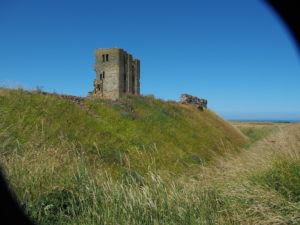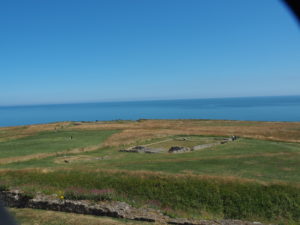Scarborough Castle with its ruined keep set high on the headland between North and South Bays, can be seen all over the town. It is a natural defensive site standing 300 feet above sea level and surrounded by cliffs on three sides. It was virtually impregnable until the arrival of heavy cannons.
Fragments of Beaker pottery have been found on the headland and there was an Iron Age settlement here. The earliest surviving remains present day visitors can see are those of a late C4th Roman signal tower. Surrounded by a protective wall and ditch, this was one of a series of signal stations along the east coast to warn of hostile vessels and intercept them.
Around 1000AD a small chapel was built here. This may have been linked to a small Viking settlement around the harbour below. This was reputedly destroyed by Harald Hadrada before the Battle of Stamford Bridge in 1066 and there is no mention of Scarborough in Domesday Book.
The present castle dates from the early C12th when William le Gros, Count of Aumâle, a powerful Anglo-Norman baron and grand-nephew of William the Conqueror began to build a castle here. He enclosed the headland with a wall with a tower at the entrance. William didn’t enjoy his status for long as in 1154, Henry II appropriated the castle, turning it into a Royal Castle, with a planned new town at its foot. Scarborough rapidly became a thriving port.
He was responsible for building he massive keep, enclosing it in an inner bailey surrounded by a ditch and wall.
John was responsible for the curtain wall which enclosed all of the outer bailey over looking the town. John’s rule was strongly opposed by the northern barons, so the castle at Scarborough was fortified as a strategic stronghold. With an eye to comfort, he also constructed the King’s Hall in the outer bailey and the Chamber Block against the curtain wall, although only the foundations of these remain.
Henry III was responsible for strengthening the entrance of the castle with the barbican and a drawbridge across the ditch. By now it ranked as one of the most formidable fortresses in England and Edward I continued to use the castle to house prisoners of war during his campaigns against the Welsh.
In 1312, Edward II made his favourite, Piers Gaveston Governor of the castle. This irked the barons who besieged the castle which surrendered after a few days from lack of supplies. Gaveston was beheaded on his way back south.
During the Hundred Years War, Scarborough was an important port for the wool trade, so was attacked several times by enemy forces. With rumours of a French invasion, the castle was repaired between 1396 and 1400.
The last King to stay in the castle was Richard III while he was assembling a fleet to resist the expected invasion of Henry Tudor. After a couple of uprisings in the C16th, the Governor was required to live in the castle to ensure its security.
The accession of James I and the political union of Scotland and England, there was no longer a threat of Scottish invasion and the castle was sold to a prominent local family, the Thompsons. The land was rented out as pasture. During the Civil War, the castle was a Royalist stronghold. It was of great strategic importance to control coastal trade and many of the supplies for Charles’s northern army came in through Scarborough. The Parliamentarians gained control of the town and established themselves in “St Mary’s Church”:http://wasleys.org.uk/eleanor/churches/england/yorkshire/north_yorkshire/north_yorkshire_two/scarborough/index.html which was used to bombard the castle with heavy cannon fire. Within three days, half of the keep had collapsed. By the end of five months, the castle capitulated having run out of gunpowder and supplies.
At the end of the Civil War, there were plans to slight the castle so it could no longer be used as a military stronghold. Opposition from the town preserved it from destruction. The castle was used as a prison for those ‘deemed to be enemies of the Commonwealth’. The castle was returned to the crown after the Restoration of the monarchy.
There was no significant work done on the castle until the failed Jacobite Rebellion of 1745, when a barracks was built within the walls of King John’s chamber block. The castle was refortified with gun batteries above the walls leading to the barbican. The Master Gunner was a very important position and he had his own house on the edge of the inner bailey.
Although Scarborough saw no action during the Rebellion, later threat of French invasion during the Napoleonic Wars meant it continued as a garrison until the mid C19th.
During World War One, Scarborough came under attack by two German warships in a raid that killed 17 people and and seriously injured another 80. The town and part of the castle keep, walls and barracks were damaged.
The castle was taken over by the Ministry of Works in 1920 and the damaged barrack block removed. It is now in the care of English Heritage and is open daily throughout the year, apart from January and February when it is only open weekends. There is a small exhibition in the Master Gunners House which also has a small tea room selling cakes and snacks.
There are a few display boards near the Master Gunner’s House with information about the history. The other display boards around the site mark stops for the audio guide.
There is no parking at the castle although there is a pay and display park by St Mary’s Church and also on street parking. The nearest post code is YO11 1HY and the grid reference is TA 049 891.
There are more pictures “here.”:http://wasleys.org.uk/eleanor/castles/england/yorkshire/scarborough/index.html









